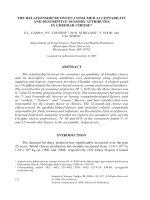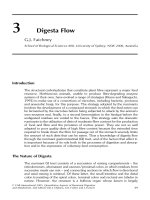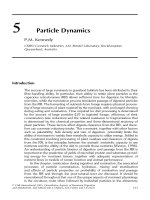Dipti Sahu and Vinod Kumar Sahu2
Bạn đang xem bản rút gọn của tài liệu. Xem và tải ngay bản đầy đủ của tài liệu tại đây (432.11 KB, 8 trang )
Int.J.Curr.Microbiol.App.Sci (2020) 9(5): 700-707
International Journal of Current Microbiology and Applied Sciences
ISSN: 2319-7706 Volume 9 Number 5 (2020)
Journal homepage:
Original Research Article
/>
To Quantify Farm Women Involvement in Agriculture and Allied Activities
Under Prevai Ling Cropping System and Practices in Chhattisgarh State
Dipti Sahu1* and Vinod Kumar Sahu2
1
Department of Farm Machinery and Power Engineering, Vaugh School of Agricultural
Engineering and Technology, Sam Higginbotton Institute of Agriculture, Technology and
science, Allahabad (U.P.), India
2
Agricultural engineering, Chhattisgarh Agriculture Engineering College, Bhilai, Durg
(Chhattisgarh), India
*Corresponding author
ABSTRACT
Keywords
Women’s
Participation in
Agriculture works,
Work Participation
rate, Economically
Active Female
Article Info
Accepted:
05April 2020
Available Online:
10 May 2020
The entitlements of women farmers will be the key to improve agriculture
productivity, It said, even as it noted that there is an increasing number of
women in multiple roles in agriculture sector, as cultivators entrepreneurs
and laborers. Alongside, it is focusing on women self – help groups to
connect them to micro credit through capacity building activities and to
provide information and ensure their representation in decision-making
bodies. “Rural women are responsible for the integrated management and
use to diverse natural resources to meet the daily household needs. This
requires that women farmers should have enhanced access to resources like
land, water, credit, technology and training which warrants critical analysis
in the contest of India,”
agriculture. Our country has a wide and very
old setting of agriculture of about 10 thousand
years. At present in terms of agriculture
production of the country holds second
position across the world. The agricultural
production in India encompasses field crops,
fruit crops, planting crops, livestock, forestry,
fishery etc. So overall it is a huge industry
Introduction
The advent of settled life happened with the
beginning of agriculture when people started
cultivating food for their livelihood.
Agriculture is the vertical backbone of the
country. Major part of the country’s
population earns its livelihood from
700
Int.J.Curr.Microbiol.App.Sci (2020) 9(5): 700-707
which recruits or engage 52% of overall
manpower of India. The rural population of
our country is mostly depending on
agricultural activity.
the respondents during agricultural works,
training needs, awareness about extension
officials and decision making pattern in
family.
The agriculture in country’s GDP, Indian
agriculture continues to remain the leading
industry in the country contributing vastly in
the socioeconomic growth of India. State likes
Punjab, Uttar Pradesh, Madhya Pradesh,
Andhra Pradesh, Haryana, Bihar, West
Bengal and Chhattisgarh are the leading states
in the terms of agricultural contribution of the
country followed by the rest. In developing
country like India, agriculture continues to
absorb and employ 2/3rd of the female work
force but fails to give them reorganization of
employed labour. Despite of the major
productive women labor force in agriculture
their needs and problems are somewhat
ignored by the rural development initiatives.
Women’s contribution in agricultural and
allied activities
In rural India, the percentage of women who
depend on agriculture for their livelihood is as
high as 84%. Women make up about 33% of
cultivators and about 47% of agricultural
laborers.
Bargali et al., (2009) has Selected farmers
randomly from five villages (i.e., 20 from
each village) in three blocks of Durg during
of Chhattisgarh plains, a participatory rural
appraisal survey conducted from 1998 to
2005. After random selection, women farmers
were categorized on the basis of their
landholding. 30 large (>4 ha), 41 medium (2–
4 ha), and 29 small farm women (1–2 ha)
were included in this study. After the
selection of the farm women, a semi
structured interview was conducted and data
were recorded on their participation in
different cultural practices of paddy
cultivation. Some observations such as
seedling transplanting, harvesting, and
threshing and storage of grains and straw
were also made. Minimum participation
occurred in fertilizer management (2–10%)
but participation was maximum in
transplanting of paddy seedlings (89–93%).
During the observations, it was noted that
transplanting efficiency (number of seedlings
transplanted in a unit area at one time) and
harvesting efficiency (a unit area harvested by
Marothia and Sharma (1985) reported that,
the women’s contribution to the farm sector
has largely been ignored and inadequately
understood in the Indian context. According
to the latest census, 38 per cent of all
agricultural labourers, 20 per cent of
cultivators and 29 per cent of all livestock and
forestry workers are women. Contributing a
fair share of working population, women form
part of a valuable human resource that, with
appropriate training and education can bring
about phenomenal changes in desirable
direction.
Mean involvement of farm women
The main focus in this study was on assessing
the farm women’s involvement in agriculture
and allied activities. However some social
factors were also included with the
assumption that they are important.
Information on respondents knowledge,
education, occupation, landholding status,
availability of milch cattle and bullocks,
method of grain storage, cropping pattern,
time spent by respondents in domestic, cattle
rearing, agriculture and other related activities
from crop production to post harvest
operations, drudgery level in carrying out
these operations, possession, awareness and
operation of improved farm tools and
equipment, food items prepared at home own
consumption, physical discomfort faced by
701
Int.J.Curr.Microbiol.App.Sci (2020) 9(5): 700-707
farm women/farmers at one time) of women
workers was 26% and 14%, respectively,
higher than that of men workers. The
maximum work participation was followed by
harvesting of the crop (70–89%), storage of
grains (70– 83%), threshing (37–42%),
transportation of the harvested crop (29–
38%), nursery preparation (10–20%),
irrigation of crops (10–15%), land preparation
(10–15%), and seed selection for sowing
operations (5–15%). After that result he
observed there is a need to prepare action
plans for providing the skills that could
enhance the working efficiency and economic
conditions of rural women.
collection work. In this study 30 farmers
including women from each of the village
(total four) were interviewed personally for
recording all necessary observation as per
proforma developed.
Location of the Study Area
The District Head Quarter of Durg Balod is in
Durg, which is situated on National Highway
200. Durg is 35 km from State capital Raipur
through road route. District head quarter Durg
is also connected with Rail Line of SouthEastern-Central Railway. It is situated on
Howrah-Mumbai main line. State capital
Raipur is 40 km from Durg through Rail
route. The railway station of district Durg and
Bhilai Nager.
The analysis revealed significant difference
between the women agricultural labourers of
Kerala and Tamil Nadu with respect to their
overall labour efficiency level. The difference
was mainly due to labour attachment practices
and increasing demand for non-agricultural
works. Dimension-wise analysis of labour
efficiency showed that majority of them
belonged to the high group under the
dimension adjustability and competency,
whereas majority had low efficiency with
respect to dimensions such as determination
in work situation, inter-personal relationship,
team spirit, commitment, work environment,
socio-economic
and
situational.
The
respondents were observed to have neither
high nor low efficiency in case of confidence
dimension.
On the basis of area Durg Balod district is the
third smallest district of Chhattisgarh State
having an area of 4015 km2. It is situated
north of Mahanadi and is surrounded by
Raipur, Rajnandgaon, Kanker & Dhamtari
districts. The total population of the district as
per census 2011 is 1316140, having the
highest population density of 342 within the
State. The district is administratively divided
into 8 development Blocks and having total
913 villages and 6 Townships.
The Gangrel project has been considered as
life supporting canal for the district Durg
Balod. The Normal rainfall is 1478 mm in the
district. Total 889 km2 area of the district is
covered by forest. Agriculture is the main
occupation of the district. Net sown area is
2645.59 km2 (on 2000 data) with only 672.02
km2 is double cropped area. Principal crop is
rice sown in 2605.62 km2 areas i.e. 98.34 %
of total sown area. 99.66 % villages where
provided with drinking water source. Almost
90 % of drinking water supply is from
Ground Water in the district. Total hand
pumps are 5776 where as power pumps are
3153 tapping ground water in the district. 84
water supply schemes are running tapping
ground water in the district.
Materials and Methods
Chhattisgarh state has been divided into three
Agro-climatic zone viz. Chhattisgarh plains,
Bastar Plateau and Northern Hill zone,
covering 51.0%, 28.0% and 21.0% of the
geographical area, respectively. The district
from the Chhattisgarh plains was selected.
Out of which two blocks namely Gunderdehi
and Gurur block has been identified for the
purpose of study. Two villages from each
block were selected for conduction of data
702
Int.J.Curr.Microbiol.App.Sci (2020) 9(5): 700-707
Fig.1 Map of Durg Balod district
collected
through
interview
of
the
counterparts of the farmers. Actual
observations of some activities were also
recorded during the field operations in a few
villages. The time and labour required for
various farm operations mainly field
preparation, sowing, transplanting, irrigation,
manuring, fertilizer application, weeding,
plant protection, harvesting, threshing, drying
and transportation were recorded for each
crop under study on the basis of the verbal
interview of the farmers. Thus the data in
terms of time and labour required to
accomplish different field operations and
household activities along with other basic
information were collected individually from
all the selected farmers.
Developing the Interview Schedule
To collect information leading to fulfill the
objectives of this study each farmer was
interviewed separately. In order to obtain the
complete
information
on
each
operation/activity a detailed schedule
(proforma) was developed by incorporating
the suggestions given by AICRP on UAE and
NRCWA, Bhopal. Prior to data collection.
Questions pertaining to farmers detail, agril.
operations, implements being used by farmers
and their details, implements/power source
available, animal power utilization, women
contributions and specification of implements
were asked and recorded.
Method of Data Collection:
Data Processing
The data were collected through personal
interview of the farmers and farmwomen on
the pre – tested proforma (Appendix – A) by
using recall method for all the selected
farmers falling in different categories. The
information about household activities was
Adopting standard techniques suggested by
the research workers the data thus collected
was processed. First of all the data for animal
power utilization was arranged separately for
different categories of respondents for each
703
Int.J.Curr.Microbiol.App.Sci (2020) 9(5): 700-707
village. The values thus found were arranged
in tabular form separately for each category of
farmers.
Information on respondents knowledge,
education, occupation, landholding status,
availability of milch cattle and bullocks,
method of grain storage, cropping pattern,
time spent by respondents in domestic, cattle
rearing, agriculture and other related activities
from crop production to post harvest
operations, drudgery level in carrying out
these operations, possession, awareness and
operation of improved farm tools and
equipment, food items prepared at home own
consumption, physical discomfort faced by
the respondents during agricultural works,
training needs, awareness about extension
officials and decision making pattern in
family.
Involvement of farm women in a operation
It indicates the per cent of the respondents
involvements in the particular operation. If
the involvement of farm women in
intercultural operation was 89.96% means out
of 100 respondents 89 respondent were
involved in this operation.
Mean involvement of farm women
It is the average of ten farm operations. Based
on respondents involvement in ten
operations, their mean involvement was
calculated
to
show
their
overall
involvement in agriculture.
Results and Discussion
This chapter briefly presents the findings of
the survey conducted in Durg, Balod district
of Chhattisgarh Plains region. To find out the
animal power utilization and women’s power
contribution in agriculture and allied activity
under existing farm practices, a detailed
survey of farm families comprising of
different land holding sizes was conducted.
Survey revealed that the respondents belong
to different castes, and have education level
from illiterate to college level. Many farmers,
especially those who have their own irrigation
sources, take summer paddy also.
Sampling Procedure
The main focus of study was on the animal
power utilization, tractor power utilization
and farm women and their involvement in
agriculture and allied activities in the state.
Therefore, only the draught animal, farm
women and male farmers were considered
separately for the study. To identify the
location of survey sites in the selected district
of the zone villages were grouped block –
wise. The farmers were selected randomly.
After that population of the farmers were
grouped under different categories for all the
four villages. The categories viz. marginal
(<1ha), small (1-2ha), semi-medium (2-4ha),
medium (4-6ha) and large (>6ha) of farmers,
selected in each of the village.
Villages under study and infrastructure
facility
The summary of information collected about
the sample Blocks and villages are presented
in Graph 1 and Graph 2. Two villages from
each block were selected for survey work. It
is observed that all the four villages are more
or less of the same category on the basis of
no. of farm families. All the villages were 15
to 17 km away to each other and these
villages are connected by concrete muroom
roads. In all the villages He-buffaloes is
popular as a source of draught power. Total
Selection and Measurement of Variables
The main focus in this study was on assessing
the farm women’s involvement in agriculture
and allied activities. However some social
factors were also included with the
assumption that they are important.
704
Int.J.Curr.Microbiol.App.Sci (2020) 9(5): 700-707
30 respondents from each of the village were
selected for personal interview to record the
observations.
of the district are electrified. There are eight
blocks in the district (Dondi, gunderdehi,
Gurur, Nawagarh, Bemetara, Patan, Saja and
Dondi Lohara) out of them two blocks
(Nawagarh, gurur and Gunderdehi) have only
rural population and also urban both. In four
blocks (Dhamdha, Bemetara, Nawagarh and
gunderdehi) female population is more than
males. About 22% and 13% population of the
district are Schedule Caste (SC) and Schedule
Tribes (ST), respectively. The percentage of
ST population is highest (27.14%) in Dondi,
Gurur and Bemetara Block and lowest
(6.23%) in Patan, Saja and Nawagarh Block
(Table – 1). There are six Block Resource
Centers (BRCs), one each in all the blocks.
As per 2011 census the male, female and total
literacy is 82.21%, 50.41% and 66.26%,
respectively.
General and social attributes
The population density of Chhattisgarh state
is 154 and in the district it is 342 persons per
km2. The sex ratio of state and district is very
similar to each other ranges between 989 and
999 female per thousand males. The main
dialect of the district is Chhattisgari. District
has mainly backward class population and
tribes like Satnami, Gond, Kanwar etc, are
found in the district. District is well connected
with the rest of the state through road and the
two tehsils namely, Gunderdehi and Dondi
are connected with railways. 98.15% villages
Graph.1 Category wise population in different blocks
180000
160000
140000
population in nos
120000
100000
80000
SC
60000
ST
40000
MINORITY
20000
RUARL
URBAN
0
name of blocks
705
Int.J.Curr.Microbiol.App.Sci (2020) 9(5): 700-707
Graph.2 Sex wise population in different blocks
In conclusion, the purpose of this study is to
analyze the women participation in
agriculture across diverse Indian state based
on secondary data score. Efforts were made to
systematically collate the data and analyze the
trend of women participation in each state. In
706
Int.J.Curr.Microbiol.App.Sci (2020) 9(5): 700-707
a Chhattisgarh the survey said a genderspecific intervention to raise productivity of
small farm holdings is required, as is
engagement of men and women in extension
services. In Chhattisgarh state the entire work
can be concluded with the facts that women
participation in agriculture is increasing with
time and women are now acknowledgement
with the status of agricultural workers and
participation
in
agriculture.
Though
discrimination of wages and in working status
still prevails for women labour but due to
implementation of various policies and
initiatives taken by government the
invisibility of women as an agricultural
workers is plummeting and will further
diminish in future.
machine system in Baster region. Final
report of ICAR ahhoc project pp 1-69.
Anonymous. 2001. Empowerment of
Women in Agriculture, Policy Paper11; National Academy of Agricultural
Science, India, September 2001.
Anonymous. 2005. The Kamdhenu bullocks
drawn tractor. Bhartiya Cattle Resource
Development Foundation. Rajasthan.
Website www.cowindia.org Bargali,
S.S., Pandey, K., Singh, L. and
Shrivastava, S.K. 2009. Participation of
rural
women
in
rice-based
agroecosystems. IGKV, Raipur.
Chandurkar, P.S. 2001. Training and
education on IPM. IPM Mitr. 11:91-97.
Chaudhary, H. and Singh, S., 2003. Farm
Women in Agriculture Operations.
Agricultural Extension Review. 15(1):
21-23.
Chaudhury, Sarmishtha. 2004. Invisible
Activities
of
Rural
Women.
Kurukshetra, Vol. 52, No. 9, July 2004.
Dave, A.K. 1999. Animal drawn tillage
system for rice cultivation under rainfed
condition. Agricultural Mechanization
in Asia, Africa and Latin America,
30(3): 28-30.
References
Aggarwal, M. 2003. Economic Participation
of Rural Women in Agriculture.
Economic Empowerment of Rural
Women in India, Edited by Gopal Singh
2003, RBSA Publications Jaipur,
Rajasthan.
Anonymous. 1995. Utilization of animal
energy through effective animal
How to cite this article:
Dipti Sahu and Vinod Kumar Sahu. 2020. To Quantify Farm Women Involvement in
Agriculture and Allied Activities Under Prevai Ling Cropping System and Practices in
Chhattisgarh State. Int.J.Curr.Microbiol.App.Sci. 9(05): 700-707.
doi: />
707









